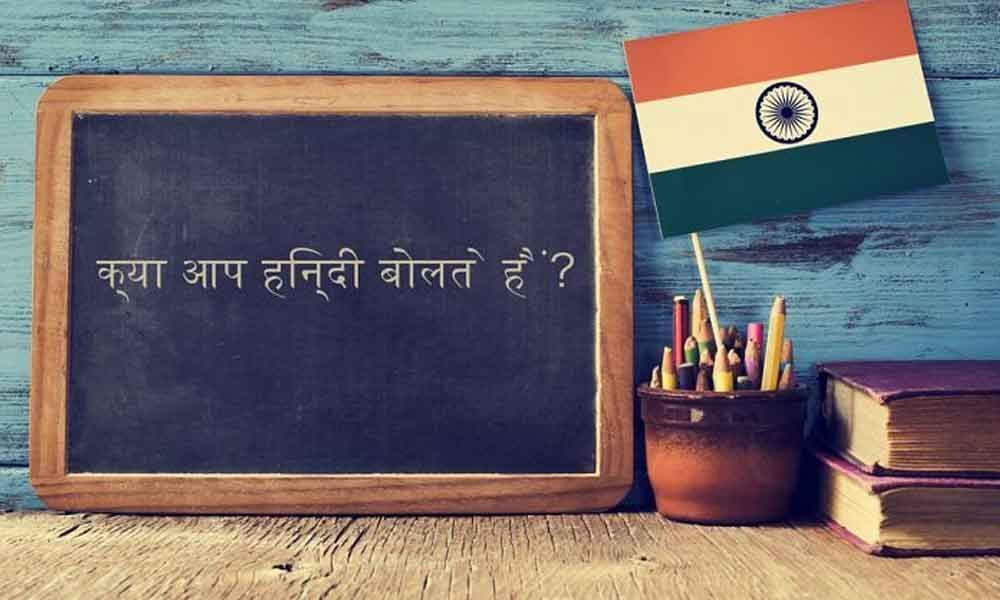Live
- Three persons admitted to hospital for diarrhea treatment
- First Star Outside Milky Way Captured: WOH G64 is 2,000 Times Larger Than the Sun
- Sikkim govt to constitute state Niti Ayog: CM Tamang
- CBI books Rajasthan narcotics inspector for Rs 3 lakh bribe
- Rajasthan bypolls: A tough contest between BJP and Congress
- Albania joins SEPA, paving way for EU integration
- Japanese government approves 250-billion USD economic package to ease price pain
- Six pharma companies to set up their units in Telangana
- The Unstable Events of a 17-Wicket Day in Perth: India vs Australia
- Dutch FM's Israel trip cancelled after Netanyahu's arrest warrant
Just In

Immediately after independence, during the ‘50s that is, Dakshina Bharat Hindi Prachara Sabha was the fountainhead for the spread of Hindi language in the South.
Immediately after independence, during the '50s that is, Dakshina Bharat Hindi Prachara Sabha was the fountainhead for the spread of Hindi language in the South.
With well-designed course material for each level for teaching the language through the local scripts of the South, the Sabha gave away certificates every half year for each level of proficiency acquired by students in Hindi.
Pradhamika, Madhyama, Rashtra Bhasha and Visarada were the different levels of qualifications culminating in Sahitya Ratna which was recognised as equivalent of M A degree.
The Devanagari script was introduced by the Sabha from Rashtra Bhasha onwards without however insisting on the use of that script by the students in the exams.
In the entire exercise of spreading the language, the services of Hindi Pracharaks (picked up from those already trained by the Sabha) spread throughout the important towns of the Southern States was remarkable.
It would also be pertinent to recall the services of Kasi Krishnacharya of Guntur in the first half of the last century in popularising the Sanskrit language among students and enthusiasts alike by using the medium of Telugu script.
Many readers of the time will recall his Sanskrit made-easy texts of Bala Bodhini. They are available for those interested in learning the language even today.
I am writing this in the context of the controversy about the introduction of a 'third' language as part of the National Education Policy. If one goes through the history of the GOI's language policy, it becomes clear that it never was serious about promoting the culture and languages other than Hindi.
Though it was mandated in the constitution that Hindi should become a truly pan-Indian language by liberally borrowing words from all the languages of the Union.
The Central Government nee the Department of Official language (read Hindi -only Hindi), however, never made any significant effort to bring a cross pollination of words from (especially) the languages of the South.
Hindi remained singularly sanskritised for the past say 65 years. As I S Johar famously quipped once, 'Yeh Akashvani hai. Ab aap samachar mein Hindi suniye', the official language of India remained moribund without absorbing any word from the different sweet languages of India.
None of the departments of the GOI had the freedom to coin new words from other non-Hindi languages even though that was the intention of the framers of the constitution.
So in the 150th year Mahatma Gandhi's birth, his hope of a unique Hindustani language evolving from the use of words, expressions and adages of different languages, has remained a mere dream.
If the present BJP Government is keen and honest in giving shape to that pan-Indian language, it should encourage setting up different language Sabhas on the model of DBHS in each of the Hindi speaking states for a period of at least the next 20 years so that they recognise and learn other Indian Languages and participate in the composition and evolution of one India. As of now, Hindi, as official language, divides India. There's no doubt about it.
Maringanti, Secunderabad

© 2024 Hyderabad Media House Limited/The Hans India. All rights reserved. Powered by hocalwire.com







